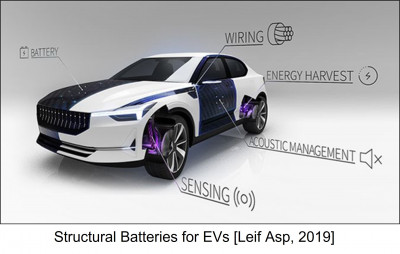News
Recent advance on the structural power composites
25 July 2021

Dr. Tan's group has recently published a paper on "Journal of Energy Storage" regarding the recent development of structural power composites. These composites can simultaneously carry mechanical load and store electrical energy. The developed electrodes possess up to 63% of their theoretical capacitance, and their tensile strengths are comparable to those of engineering alloys. Their specific power and specific energy lies between supercapacitors and lithium-ion batteries.
Abstract: The measured capacitance, modulus and strength of carbon nanotube-polyaniline (CNT-PANI) composite electrodes make them promising candidates for structural energy storage devices. Here, CNT-PANI composite electrodes are manufactured with electrodeposition of PANI onto the bundle network of CNT mats produced via a floating catalyst chemical vapour deposition process. PANI comprises 0% to 30% by volume of the electrode. The composition, modulus, strength and capacitance of the electrodes is measured in the initial state, after the first charge, and after 1000 charge/discharge cycles. Electrode modulus and strength increase with increasing CNT volume fraction; in contrast, the capacitance increases with increasing PANI mass. Charging or cycling reduce the electrode modulus and strength due to a decrease in CNT bundle volume fraction caused by swelling; the electrode capacitance also decreases due to a reduction in PANI mass. A micromechanical model is able to predict the stress-strain response of pre-charged and cycled electrodes, based upon their measured composition after pre-charging and cycling. The electrodes possess up to 63% of their theoretical capacitance, and their tensile strengths are comparable to those of engineering alloys. Their capacitance and strength decrease by less than 15% after the application of 1000 charge/discharge cycles. These properties illustrate their potential as structural energy storage devices.
This research was funded by the EPSRC project ‘Advanced Nanotube Application and Manufacturing (ANAM) Initiative’ under Grant No. EP/M015211/1, and from the ERC projects ‘Multi-phase Lattice Materials’ (MULTILAT) under Grant No. 669764, and ‘Roll to Roll Manufacturing of Li Ion Battery Electrodes’ (MIGHTY) UNDER Grant No. 866005 and the Cambridge CAPE Acorn Blue Sky Research Award (Grant No. NMZD/256).
Reference: W. Tan, J.C. Stallard, C. Jo, M.F.L. De Volder, N.A. Fleck, The mechanical and electrochemical properties of polyaniline-coated carbon nanotube mat, J. Energy Storage. 41 (2021) 102757. https://doi.org/10.1016/J.EST.2021.102757
| Contact: | Wei Tan |
| Email: | wei.tan@qmul.ac.uk |
| Website: | |
| People: | Wei TAN |
Updated by: Wei Tan

